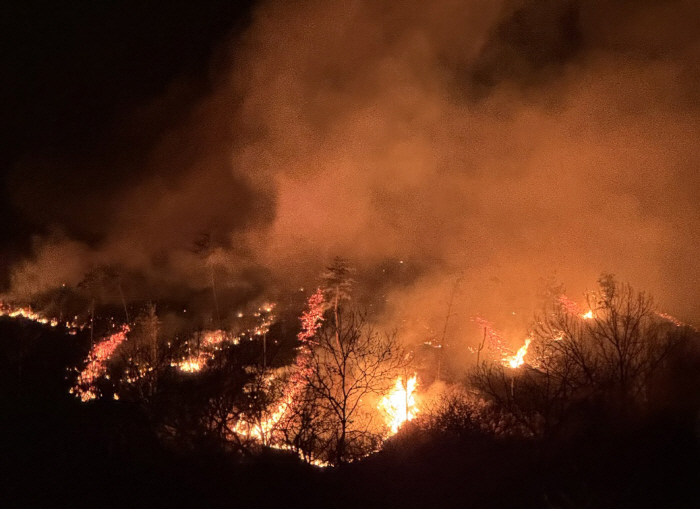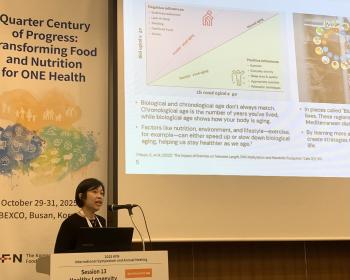Hazardous substances are dangerous even if wildfires are extinguished...Be careful of exposure to firefighters, volunteers, and residents
Apr 09, 2025
|
Ham Seung-heon, a professor of occupational environmental medicine at Gachon University Gil Hospital, said firefighters, fire disaster special fire teams, soldiers, volunteers, and nearby residents who participate in forest fire extinguishing need to be careful because of the high risk of exposure to harmful substances.
There are usually several causes of forest fires, but climate change and human activities are pointed out as major factors. In particular, dry weather and strong winds accelerate the spread of wildfires, and the damage increases if rapid extinguishment is not achieved in this situation. The work to extinguish wildfires is usually done in cooperation with firefighters and special teams.
During evolutionary work, the parties may be directly exposed to pollutants generated by the burning of various organic substances. Pollutants include complex air pollutants such as ultrafine dust (PM2.5), fine dust (PM10), carbon monoxide (CO), nitrogen dioxide (NO2), and volatile organic compounds (VOCs).
The problem still remains after the forest fire is complete. Fine dust generated during the combustion process remains in the atmosphere, which poses a serious threat to the health of nearby residents.
In particular, ultrafine dust (PM2.5) can pass through the alveoli and directly penetrate the blood, acting as a risk factor that can cause not only respiratory diseases but also cardiovascular diseases and neurological diseases. When the concentration of such fine dust increases, people with respiratory diseases may experience more serious symptoms.
Professor Ham Seung-heon said, `Firefighters participating in the forest fire extinguishing do their best to extinguish the fire, but we are concerned about the health effects of harmful substances generated in the process"There is a need for a variety of policies that allow them to be exposed to harmful substances to a minimum and to receive continuous medical examinations even after forest fires are extinguished."
Wildfire damage extends not only to those who participated in the extinguishment, but also to residents of the area where the fire occurred. In particular, fine dust and other harmful substances remaining in the atmosphere after the forest fire is extinguished have a great impact on the daily lives of residents. Residents, volunteers, soldiers and even fire inspectors and damage officers should wear appropriate personal protective equipment when cleaning up or investigating the debris where wildfires have been extinguished near the village.
Personal protective equipment includes masks that can be dust-proof and gas-proof at the same time, certified protective clothing, and protective gloves, not regular working gloves. However, this cannot be a fundamental solution, although most of the people involved in the evolution are coping with wearing KF masks. In the United States, guidelines are distributed and taught to residents when they return home after a fire.
Professor Ham Seung-heon said, "The problem of harmful substances generated after forest fire extinguishing affects the health and safety of society as a whole beyond just individual health." The government and related agencies should strengthen research and monitoring of harmful substances generated during forest fire extinguishing," he stressed.
"Through this, we need to come up with measures to protect the health of people and local residents participating in the forest fire extinguishing."
In addition, if wildfires are mixed with other fires, the difficulty of extinguishing work may be higher, so caution is needed. For example, if a wildfire spreads to an electric vehicle parked nearby and burns it, the risk is even greater. When the batteries of electric vehicles are burned, hazardous substances can be generated, which poses an additional risk to the workforce involved in the evolutionary work. Therefore, along with research on the safety of electric vehicles, there is a need for a plan to recognize and cope with the risk of electric vehicles in the event of forest fires.
Professor Ham Seung-heon said, "Hazardous substances generated in the process of extinguishing wildfires can seriously affect human health, and a systematic approach is needed to solve them."Continuous research and policy efforts are essential to protect the health of firefighters and residents."
On the other hand, there are overseas studies that show that short-term exposure to ultrafine particles (PM2.5) contained in wildfire smoke can increase the risk of vulnerable groups such as adolescents and low-income families visiting emergency rooms due to mental health diseases.
Professor Carineido's team at Harvard's T.H. Chan School of Public Health recently published a study examining the relationship between fine dust from wildfires and mental health in the Journal of the American Medical Association 'JAMA Network Open'.
The research team analyzed PM2.5 levels related to daily wildfires by region and emergency room visits due to mental health conditions such as depression, anxiety, mood and emotional disorders between July and December 2020, when the most severe wildfires on record occurred in California.
As a result, when wildfire-related PM2.5 increases by 10㎍/㎥, emergency room visits due to mental health diseases of all causes increase by 8% for 7 days after exposure.
By symptom, emergency room visits due to mood and emotional disorders increased by 29%, and visits due to depression and anxiety increased by 15% and 6%, respectively.
In particular, vulnerable people such as children, adolescents, black people, Hispanics, and low-income families are at high risk of visiting the emergency room due to mental health problems.
|
This article was translated by Naver AI translator.















